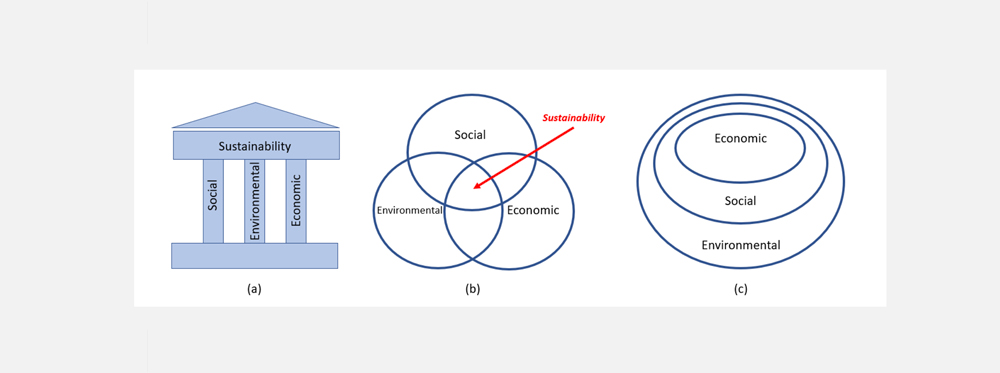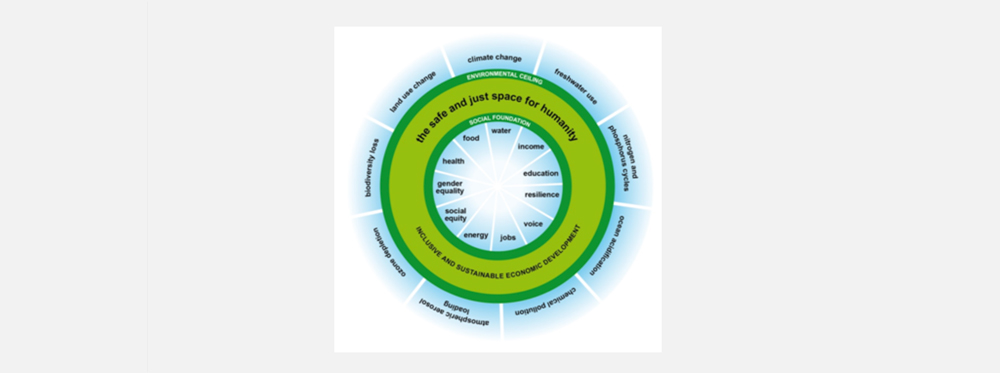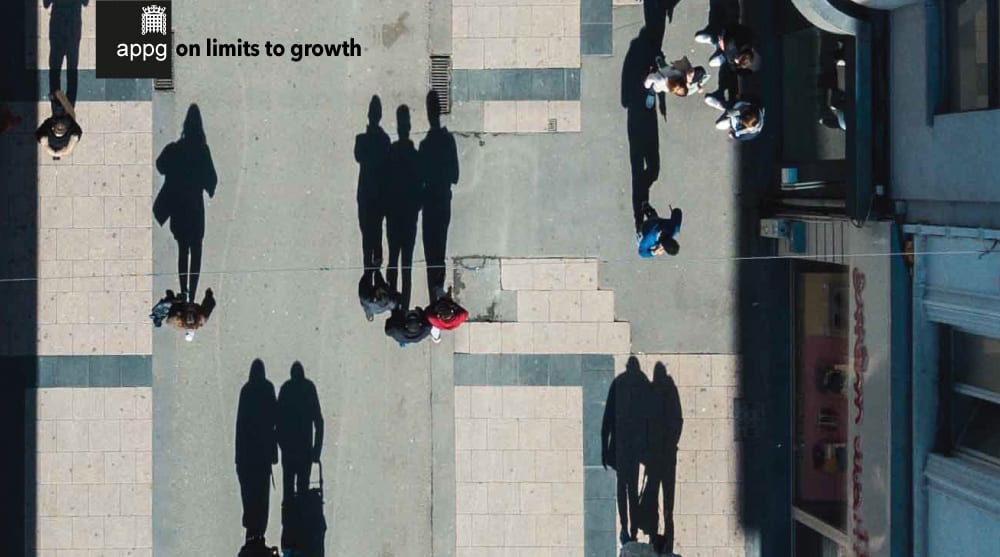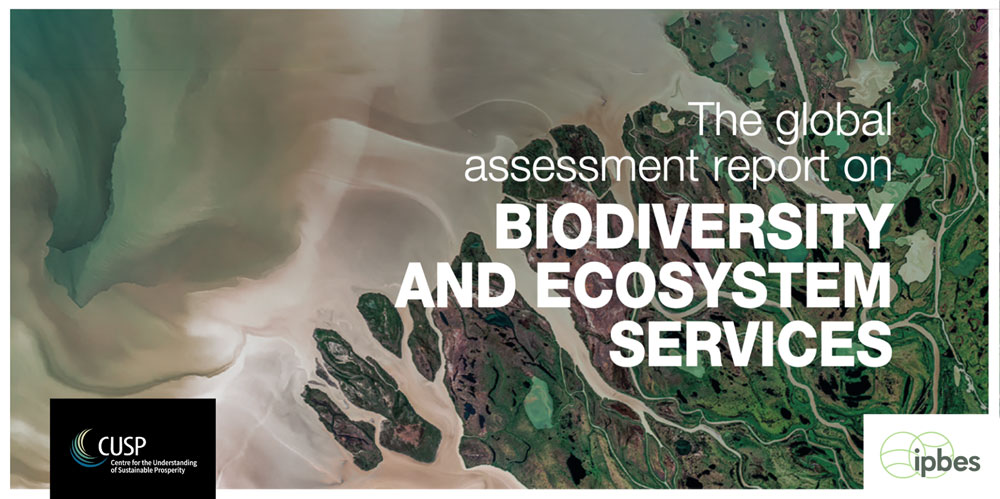Pragmatism versus transformation: assessing the suitability of sustainability frameworks for embedding sustainability in higher education curricula
Simon Mair and Angela Druckman
CUSP Working Paper Series | No 36

Summary
This paper addresses the use of sustainability frameworks in embedding education for sustainability into the curriculum of Higher Education Institutions (HEIs). We focus on the paradox that sustainability frameworks must facilitate transformation of existing structures whilst also being well-enough aligned with current conditions to be readily adopted by today’s HEIs. We propose a set of four criteria for assessing the suitability of sustainability frameworks for use across the curriculum: Relevance to Current Curricula; Language; Institutional Fit; and Concept of the Future. Using these criteria, we assess how various frameworks align with the current (unsustainable) state of affairs, and their transformative potential. The frameworks assessed are: the Sustainable Development Goals (SDGs); the Three Pillars Framework; and the Capitals Approach. We find that each of the frameworks has strengths and weaknesses: the SDGs and the Capitals Approach perform well on alignment, but less well on transformational criteria. Conversely, the Three Pillars Framework perform well on transformation and less well on alignment criteria. By applying the criteria set out in this paper, we hope those working to embed sustainability into the curricula of HEIs will be better equipped to navigate the tensions presented by sustainability transitions.
1 Introduction
The starting point for this viewpoint paper is that Higher Education Institutes (HEIs) have a key role to play in a sustainability transition, and that, to achieve this, education for sustainability needs to be embedded in the education of all students (Cortese, 2003, O’Riordan et al., 2020). Our view is that sustainability should not be an “add-on” that supplements students’ degree courses: it must be integral to all learning. In this way, higher education can facilitate widespread understanding and thus empower the next generation of leaders to make transformative advances towards sustainability.
Underpinning our starting point is the belief that change must simultaneously be transformative and incremental. Transformation comes at the level of collective ideas. Currently our ability to build sustainable societies is constrained by a set of unsustainable collective beliefs. The idea that human needs are infinite, that economic growth is essential to wellbeing, and that the economy can be separated from the environment are all examples of beliefs that make up today’s unsustainable imaginary (Mair et al., 2020, Jackson, 2017). These and other beliefs come together to create a world in which we appear to have lost the ability to collectively imagine alternative, sustainable, futures (Fisher, 2009, Mair et al., 2020). A necessary step in building an alternative is to create new collective beliefs around which new material institutions and systems can be built (Meadows, 2008, Göpel, 2016).
This theory has implications for education provided by HEIs. It implies a role for HEIs in graduating students with radical and transformative ideas (Cortese, 2003, O’Riordan et al., 2020). But it also implies that these students must be able to engage with the world around them as it is today. This means developing students with the capacity to work within existing organisations in order to make incremental changes.
In this paper we propose a set of criteria to evaluate how different sustainability frameworks might be used to support the embedding of sustainability in higher education curricula. The aim of the criteria is to help those working to embed sustainability in students’ education to navigate the tensions between incremental and transformative change. We apply the criteria to three sustainability frameworks.
The structure of the paper is as follows. In the next section we present our criteria for evaluating sustainability frameworks. In Section 3, we outline three possible frameworks that could be used (the Sustainable Development Goals (SDGs); the Three Pillars Framework; and the Capitals Approach), and evaluate them against the criteria. Section 4 concludes.
2 Criteria for assessing the usefulness of sustainability frameworks for education for sustainability
We propose four pairs of criteria to help educators evaluate how different frameworks might work in their context. The criteria are focused on how well (A) each framework fits with the Current Curricula, (B) the Language it uses, (C) its Institutional Fit, and (D) its Concept of the Future. These criteria draw from two key literatures. First, the transitions literature that sees the need for radical transformation of ideas and cultures capable of guiding incremental change (Göpel, 2016, Linnér and Wibeck, 2020). Second, the Education for Sustainability literature that seeks to understand processes of change for sustainability within HEIs (Bowers, 2009; Cachelin et al., 2015; Bradley, 2019).
We are particularly interested in the inherent tension between incremental and transformative change. Incremental change is needed: all transformation must start somewhere, and incremental change can open a door to wider more radical transformation (Göpel, 2016, Weeks, 2011). However, incremental changes also risk reinforcing the system as it is and constraining the possibilities for transformation (Utting, 2018). Our criteria set out below aim to help its users understand where different sustainability frameworks fall on this spectrum.
2.1—Relevance to current curricula
- A.1 Aligned to Current Curricula. The framework must be readily applicable to all disciplines.
- A.2 Transformative of Current Curricula. The framework must transcend traditional disciplinary barriers, emphasising that humans are a part of the biophysical environment.
Aligned to Current Curricula means that the sustainability framework can be readily taught and analysed from the perspective of existing academic disciplines. This is important because, while there are examples of courses that cut across disciplines, implementing such courses at scale is often very difficult. Previous attempts to create large scale cross-disciplinary sustainability courses have met their pedagogical goals but have had to be abandoned because they run into logistical and administrative barriers associated with working across faculties (e.g. Marcus et al., (2015)). Additionally, alignment can facilitate a sense of agency and ownership among educators by allowing them to teach sustainability within their own disciplinary context (Marcus et al., 2015, Frisk and Larson, 2011).
On the other hand, an established principle of sustainability and education for sustainability is that it must transcend traditional ways of thinking and learning. Eco-feminist philosophy argues that the basic ontological assumption of Western systems of knowledge is that nature and humanity are two separate entities (Plumwood, 1993). This duality is seen as a major contributor to the development of unsustainable societies (Mair et al., 2020, Ruder and Sanniti, 2019). Consequently, sustainability educators have argued that sustainability education must move beyond disciplinary boundaries and Western understandings, emphasising the biophysical basis on which all systems depend (Huckle, 2004, McKenzie, 2012).
2.2—Language
- B.1 Aligned Language The framework should allow students to speak the same language as future employers and colleagues.
- B.2 Transformative Language. The framework must provide a language that enables students to go beyond the norms of unsustainable societies.
The ability to speak the same language as others is key enabling incremental change. Research from a variety of sectors points to the need for shared language around sustainability (Gitsham, 2012, Sutton, 2019, Wiek et al., 2011). If this is missing it acts as a barrier to change. Describing their experience returning to work after taking part in a training programme, an interviewee from IBM points to the difficulties of trying to affect change in the absence of common language: “There is a divorce between these programmes and the day to day and what managers really understand… You need the same language and concepts in order to understand each other, but the managers don’t have this. People come back from the programme and others around them don’t understand” (Gitsham, 2012 p. 305).
However, language that is too well aligned with unsustainable structures can limit the ability of graduates to transform these structures. As Bowers (2009) argues, when we use the metaphors and language that were used to legitimise unsustainable aspects of today’s society we risk allowing these same dynamics to dominate student thinking about the future. Discussing economics more specifically, Raworth (2017) points to the diagrammatic language used to teach economics students. She argues that it limits their thinking by excluding the environment altogether. Consequently, Raworth proposes a new set of diagrams to provide the basis for economics education. These theoretical arguments are supported by Cachelin et al.’s (2015) experimental data suggesting that the metaphors used to introduce students to sustainability have profound effects on whether they come to think of it in individualistic or community led terms.
2.3—Institutional Fit
- C.1 Aligned to Institutions. The framework should be synergistic with other requirements of the HEI.
- C.2 Transforms Institutions. The framework must provide a way to resist the unsustainable forces that drive requirements of HEIs.
Alignment to institutions describes how well sustainability frameworks align with pre-existing priorities and structures of the university. For example, we might look at the extent to which a framework can be integrated into current reporting metrics. Being well aligned to existing institutional priorities enhances the likelihood that sustainability in the curriculum will be adopted as an official policy, as it will increase the visibility of sustainability at senior management levels within the HEI (Marcus et al., 2015). This is important because promotion by senior management is helpful as it gives instructors the scope and resources to change their teaching (Bradley, 2019). Indeed, existing metrics like employability are often leveraged in support of incorporating sustainability into teaching (Bradley, 2019, Denby and Rickards, 2016).
However, HEIs are shaped by the same forces that drive unsustainability in other institutions. The increasing use of reporting metrics is linked to individualisation and marketisation (Morrish, 2019), both of which are associated with prioritising economic growth at the expense of social and environmental goals (Jackson, 2017). So, while some metrics can be used by teachers to incorporate sustainability, others are barriers to sustainability. Bradley (2019), for example, finds that the UK’s Research Excellence Framework is a barrier to integrating sustainability into economics as it reinforces traditional disciplinary boundaries and objects of study, while The Times Higher Education Impact Rankings encourages teaching of sustainability.
2.4—Concept of the Future
- D.1 Aligned concept of the future. The future posited by the framework should be compatible with today’s dominant future imaginaries.
- D.2 Transformative concept of the future. The future posited by the framework should be truly sustainable and detail the transformations required for this.
Imaginaries of the future are central to the way that societies run in the present and how they reproduce themselves over time (Göpel, 2016). For example, business plans are narratives about the future that effect investor behaviour in the present. Likewise, adverts aim to change your consumption today by showing you the ways in which a product will change your tomorrow (Davies, 2018).
Alignment to the concepts of the future that currently dominate society makes it easier for students to integrate their sustainability visions into today’s society. Imaginaries of the future typically recreate today’s social structures and assume advances in technology will alleviate environmental impacts (Slaughter, 2004, Mair et al., 2020). By definition, any concept of the future that breaks with this imaginary requires building new social structures that will threaten current dominant interests and power. Therefore, when students go out and attempt to implement their new visions they will face barriers to implementation.
However, many of the future imaginaries that dominate society today are unsustainable and students must be prepared to change them if we are to achieve sustainability. Sustainability educators point to economic growth as a dominant and problematic future imaginary of neoliberalism (Kopnina, 2018, McKenzie, 2012, Shanks, 2020). Historically, economic growth has been associated with increased carbon emissions (Jackson, 2017). Indeed, economic historians argue that the discovery and widespread use of fossil fuels was integral to the industrial revolution and rapid economic growth that followed (Wrigley, 2016, Malm, 2016). Breaking with this past trend is unlikely given the social structures that surround growth. Consumer capitalism rests on an ever expanding production and consumption of goods, all of which have some material basis (Jackson, 2017).
Equipping students with a transformative understanding of the future has a long tradition in radical and liberation pedagogy. Freire (1970) argues that liberation-focussed pedagogy must reject both the idea of a continuation of the present and the idea that a better future is inevitable. Instead, education must take a view of the future as something to be struggled for and constructed.
2.5—Flexible use of the criteria
Before we move onto the next section, it is important to recognise the value of pluralism in sustainability education. Different frameworks have different strengths and may be useful in different contexts. For example, the requirements of HEIs at different stages of their journey towards embedding sustainability in the curriculum may vary. For example, criteria C.1 (the framework should be synergistic with other HEI reporting requirements), will be of more importance when struggling to get a policy agreed by top management of an HEI, than after agreement has been reached and the key focus has turned to implementation within specific disciplines. Hence the criteria should be flexible and used according to the conditions of specific HEIs, or parts thereof, at particular stages in their journey.
3 Candidate sustainability frameworks
In this section we introduce three possible sustainability frameworks for use in embedding sustainability within curricula in HEIs. While different disciplines have different requirements and may need different frameworks applied within their own curricula, a number of studies point to a need for a common framework across HEIs. For example, previous attempts to build integrative interdisciplinary sustainability course have failed, in part, due to language barriers across disciplines (Purvis et al., 2019; Denby and Rickards, 2016). We also see an opportunity for university curricula to help build new, sustainable, collective beliefs – what Meadows et al (1972) would call a paradigm shift, or what Göpel (2016) calls “the great mindshift”. However, this requires some level of agreement on what sustainability is (or is not). With this high-level goal in mind, we evaluate the Sustainable Development Goals, The Three Pillars Framework, and the Capitals Approach against the criteria set out above. We summarise this assessment in Table 1.
3.1—The United Nations Sustainable Development Goals (SDGs)
A major milestone in global progress towards sustainability was reached in 2015 when 193 countries signed up to the United Nations Sustainable Development Goals (SDGs) (see Figure 1a). Used together, the 17 Goals are intended to set out a comprehensive roadmap for sustainable development. When taken as a whole, the SDG framework can be considered visionary. It is well established and widely adopted, with surveys suggesting that a majority of businesses see the SDGs as useful (Bebbington and Unerman, 2018). Thus, it is well aligned with existing language and is likely to facilitate students to communicate with future employers and colleagues using a common language (B.1, Aligned Language).

Figure 1 | The United Nations Sustainable Development Goals and alternative representations thereof. [Sources: (a) UN (2015); (b) Rockström and Sukhdev (2016); (c) Waage et al (2015) page 251]
HEIs report against the SDGs for a variety of organisations and league tables, and hence the SDGs are aligned with current institutional requirements (C.1). For example, along with 109 other institutions, the University of Surrey has signed up, and reports to, the SDG Accord[1]. It also submits to the Times Higher Education (THE) Impact rankings, which requires HEIs to report against selected SDGs, from this HEIs are placed in league tables. It was no coincidence that the University of Surrey’s Education for Sustainability Strategy[2] was granted official approval at the time of writing the THE Impact Rankings submission. Moreover, such reporting is expected to increase: participation in the THE Impact Rankings increased from around 450 institutions in 2019[3] to 1,406 in 2022[4].
The SDGs also show alignment to the current curricula (A.1), as it is easy to identify specific goals relevant to each discipline. This is useful when trying to engage students and staff from specific disciplines. For example, Frey and MacNaughton (2016) discuss Goal 8 (Decent Work and Economic Growth) from an international human rights law perspective, while Mair et al., (2019) approach it from an economic perspective. Likewise, Yang et al., (2017) provide a number of examples of ways that systems metabolic engineering contributes to different goals.
However, when we consider the application of the SDGs (and when specific Goals and their targets are scrutinised in detail) the SDGs fall short on some of the transformational criteria. The SDGs emerge from a global governance context dominated by neoliberalism and an imbalance of power between the global north and global south. It is not surprising, therefore that they reflect these structures (Muchhala and Sengupta, 2014, Spann, 2017). Similarly, the SGDs represent a substantial compromise between different parties of the United Nations (Kamau et al., 2018).
One result of the compromises is seventeen Goals, and this is too many for people to grasp. Hence the SDGs may not offer a fully integrative, transformative approach to sustainability (criteria A.2) due to the tendency to focus on individual Goals (or subsets of them). For example, we have already mentioned two studies that focus on Goal 8 (Mair et al (2019) and MacNaughton (2016)). A further example of this “cherry-picking” is that submissions to the THE Impact Rankings allow HEIs to choose which Goals they report on. Such selectivity goes directly against the holistic intentions of the SDGs, and enables sidestepping of major issues such as climate change and biodiversity loss. Without a functioning Earth on which humans can survive, we cannot even start to think about issues such as decent work.
The Stockholm Resilience Centre has developed an alternative representation of the SDGs (see Figure 1b), which attempts to overcome this flaw by representing the SDGs as a hierarchy. Known as the “Wedding Cake” diagram, this configuration shows the Goals which underpin the physical foundations on which human life on Earth depends in the lower layer. Goals that focus on the flourishing of society are placed in the middle layer, with economic goals on the top layer. Another, less well known representation of the SDGs that also emphasises the necessity of addressing the biophysical Goals, has been developed by Waage et al (2015). As shown in Figure 1c, they place the Natural Environment as a constraining circle around all other issues, encompassing infrastructure requirements, and placing well-being in the centre. These alternative representations of the SDGs push for transformation towards strong sustainability more than the traditional representation (D.2), and challenge the status quo using a language beyond that which is widely accepted (B.2).
Another result of the compromises made in order to reach agreement on the SDGs is that there are many trade-offs between individual Goals (Kroll et al., 2019). A key example of this is between SDG8 “Decent Work and Economic Growth” and SDG13 “Climate Action”. Jackson (2017) estimates that to stay under 1.5 degrees of warming (IPCC, 2018), and allow the economy to grow as it has in recent decades, then we must decarbonise the global economy at a rate of more than 8.6% per year. This is almost an order of magnitude greater than observed rates of decarbonisation in recent decades (Jackson, 2017). Thus, in our view, SDG 8 encourages unsustainability, by not making this trade-off apparent at a high-level. Such trade-offs arise from alignment with current imaginaries of the future (D.1). While this may ease implementation with current structures, it suggests a limited transformative capacity in terms of future imaginaries (D.2) and language (B.2).
In summary, as shown in Table 1, the SDGs generally perform well on the aligned criteria and poorly on the transformational criteria, with the alternative representations moving them towards the more transformational criteria.
3.2—Three Pillars Framework and variations thereon
The traditional way of explaining sustainability is the three pillars framework (Figure 2a) (Purvis et al., 2019). This framework presents social, environmental and economic issues as separate columns on which the flourishing of society rests. It has also been used as the Triple Bottom Line approach for businesses which proposes accounting for social, environmental and economic issues in the ‘bottom line’ of company reporting (Elkington, 1998). In the Venn diagram representation of this (Figure 2b) sustainability is represented by the overlapping of the three spheres of Social, Environment and Economic issues. Although these two diagrams show that to make progress towards sustainability, attention must be paid to all three issues, the representation in which the issues are nested, shown in Figure 2c, better emphasises that there are fundamental biophysical requirements for human flourishing.

Figure 2 | The Three Pillars of Sustainability framework and related depictions
The strength of the three pillars approach is its simplicity: in particular, the frameworks shown in Figures 2a and 2b suggest that a balance between social, economic and environmental issues will achieve sustainable development. However, it is this simplicity that is also its main weakness, as it ignores the complex dynamics, interconnectedness, risks, uncertainties, trade-offs and ethical dimensions that are key features of human-environment systems (Mensah, 2019, Messerli et al., 2019, Clark, 2007). In particular, Figure 2a, in which the three pillars are given equal height, suggests that the economy is independent of the environment. This arose from the belief that the supply of natural resources is unlimited (Mensah, 2019) and gave rise to the dominant mantra of economists that infinite economic growth is a rationale and achievable goal – a mantra that is fiercely challenged by ecological economists (Meadows et al., 1972, Jackson, 2017).
Furthermore, the simplicity of the social issues is deceptively misleading, as social issues incorporate a diverse set of complex and intertwined concepts, that include inter- and intra-generational equity, gender and racial equality, empowerment, agency, public participation and justice (Mensah, 2019, Gough, 2017). Social wellbeing, which is arguably the goal of the social pillar, is often approached from two angles: the humans needs approach (Gough, 2017) and the capabilities approach (Sen, 1993). Sen defines capabilities as “the various combinations of functionings (beings and doings) that the person can achieve. Capability is, thus, a set of vectors of functionings, reflecting the person’s freedom to lead one type of life or another … to choose from possible livings” (Sen, 1992: page 40). It thus focuses on capabilities rather than achieved ‘functionings’ (Sen, 1992). In contrast, human needs theory posits that “Health and autonomy are basic needs which [all] humans must satisfy in order to avoid the serious harm of fundamentally impaired participation in their form of life” (Gough, 2014: page 4). A basic difference between the two of these is that the needs approach is absolute and can be applied in any society (albeit using different “satisfiers”), whereas the capabilities approach is relativist. The simplicity of the social pillar thus belies the sorts of debates that underlie the word “social” in the frameworks of Figure 2.
While the nested depiction (Figure 2c) does not overcome many of these critiques, it has been built upon by other frameworks which go some way towards this. An example is the Doughnut Economics framework, which depicts a ‘safe and just operating space for humanity’ (Raworth, 2017). As shown in Figure 3, environmental limits are placed at the outer limits, as in the nested three pillars depiction (Fig 2c). However, Raworth has developed this further, transforming the simple economic and social spheres of Figure 2c, to show the safe and just operating space where humanity must strive to be placed within the doughnut, emphasising that for a just operating space broad social and economic foundations must be met. These include adequate food, water, education, income and energy, alongside provision of adequate health, good jobs, social equity and gender equality. Furthermore, the doughnut specifies provision of support to provide resilience, and freedom of political expression and participation (voice).

Figure 3 | Doughnut Economics. Source: (Raworth, 2014)
The Three Pillars framework performs relatively well on transformational criteria, and worse on alignment criteria (Table 1). With regards to criteria D.2 (transformative concept of the future), the nested representation (Figure 2c) performs well as it explicitly depicts human systems as subsets of, and dependent upon, the biophysical system, and, as described above, has been used for more transformational concepts such as Doughnut Economics. Moreover, the nested diagram sits at the heart of transdisciplinary efforts to understand humanity as a part of the biophysical world (A.2). However, working out how the nested concept can be applied to various disciplines can be tricky, and this may lead to difficulties developing teaching within existing university structures. Furthermore, the three pillars framework, while being well known, is hard to operationalise (Purvis et al., 2019) and therefore has limited potential for developing a shared language with those outside sustainability (B.1) . As far as we are aware, the three pillars are not used for other requirements within HEIs such as reporting (C.2), although, in theory, the triple bottom line variant may be possible to integrate with university metrics (C.1).
3.3—Capitals Approach
The capitals approach is an umbrella term for a number of frameworks based on ‘capitals’. In these frameworks, capitals are defined as stores of value that get changed by the actions of organisations (Adams et al., 2013). Together, these capitals make up the value on which we all depend for our wellbeing, now and into the future. While the concept of capital has its roots in economics (Missemer, 2018), Pearce (1988) was arguably the first to introduce the concept of natural capital, thus making the concept directly relevant to sustainability.
The core concept of the capitals approach is that social and environmental impacts that arise from the actions of an organisation, but which do not impact that organisation’s short-term performance, should be monetised and thus better taken into account in decision-making (Unerman et al., 2018). This, for example, enables eco-systems services provided by the natural environment to be included in decision making tools such as economic cost-benefit calculations (Turner et al., 2003). The approach is, however, highly controversial, with critics arguing that systems for assessing the monetary value of externalities are flawed (Unerman et al., 2018). Another fundamental critique of this approach is the inherent assumption that different types of capitals (or different services within one type of capital) are substitutable (De Groot et al., 2003). Thus the marketisation of nature in the capitals approach places the capitals approach squarely in the field of weak, rather than strong, sustainability (Victor, 2020) (D.1). Indeed, Victor (2020: p1) warns that “such valuations should be used with great caution or not at all in informing decisions and driving public policy the out-comes of which have environmental consequences”.
Despite these critiques, the capitals approach is the basis of ‘integrated reporting’, which is rapidly being adopted for corporate reporting[5]. An integrated report is “a concise communication about how an organization’s strategy, governance, performance and prospects, in the context of its external environment, lead to the creation of value in the short, medium and long term” (IIRC, 2020a). This movement was led by the International Integrated Reporting Council (IIRC), a global coalition of regulators, investors, companies, standard setters, the accounting profession, academia and NGOs that promoted communication about value creation using corporate reporting (IIRC, 2020b)[6]. The IIRC released its 6 capitals framework (Figure 4b) in 2013 (Adams et al., 2013). This was based on Forum for the Future’s Five Capitals framework (Figure 4a) that had been developed in the 1990’s (Parkin, 2000).

Figure 4 | Forum for the Future Five Capitals Framework (a), and the International Integrated Reporting Council (IIRC) Six Capitals Framework (b). Sources: Forum for the Future (undated) and Adams et al (2013) p 3.
While the capitals used in company reporting are generally as depicted in Figure 4b, the choice of capitals is flexible. For example, in Durham University’s Annual Report, the capitals used are: People – which is akin to social and relationship capital; Knowledge, which is roughly equivalent to intellectual capital; Buildings and equipment which is equivalent to manufactured capital; Natural resources; Partnerships and networks which is akin to social capital; and Funding, which replaces financial capital (Durham University, 2019b).
The Capitals Approach was selected for inclusion in this paper primarily for its relevance to businesses, therefore, as may be expected, it performs well against alignment criteria, but less-well against transformative criteria. For example, many global leading companies such as Unilever, Tata Steel and Marks and Spencer now publish integrated reports, and therefore this performs well on criterion B.1 (Language). Also it is relatively easy to see how the capitals approach can be applied to various different disciplines, and, in particular capital metaphors are now applied across social sciences such as history (Zajda and Whitehouse, 2009) (A.1). Results are mixed on alignment to institutions (C). In the UK, Advance HE published a report that sets out how universities can use the capitals approach and integrated reporting (Adams, 2018). However, while some universities have heeded the report’s call, such as the Universities of Edinburgh and Durham (University of Edinburgh, 2016: p29, Durham University, 2019a:p9), this practice is not yet widespread (IIRC, 2020c), and hence the Capitals Approach does not perform as well against criterion C.1 as the SDGs. As mentioned above, the capitals approach is founded on the economic concept of “capital”, and thus, arguably, reinforces the idea that humanity can control, and is not a part of, the biosphere (D.1) and therefore it performs poorly against criteria D.2 (transformative concept of the future).

Table 1 | Summary of performance of candidate frameworks of sustainability against the criteria.
4 Conclusion
In this paper we describe a novel set of criteria for assessing sustainability frameworks, that is designed to be used by educators attempting to embed sustainability into the curriculum at HEIs. Our criteria emphasize the conflicting requirements of a sustainability framework and the need for change that is simultaneously transformational and incremental. On the one hand, sustainability frameworks must enable incremental change within existing educational structures. To achieve this, they must be aligned to the current curricula, use language that allows students to communicate with future employers and colleagues, fit within other requirements of the HEI, and be compatible with dominant visions of the future. On the other hand, successful implementation of sustainability requires us to go beyond alignment with society as it is today and seek to transform it. This requires a sustainability framework that transforms the current curricula, uses language that helps students and staff imagine new ways of being, challenges the existing priorities of HEIs, and presents a transformative vision of the future.
Of the three frameworks that we assessed against the criteria, each has its strengths and weaknesses. The Three Pillars approach performs well on transformation: this is particularly true of the nested representation due to its emphasis on human systems as a subsystem of the biophysical world. For example, this representation has been used as a basis for innovative sustainability frameworks such as Raworth’s (2017) Doughnut Economics. The Capitals Approach has strong resonances with dominant ways of thinking, and is increasingly being used as a basis for corporate reporting: therefore it performs well on alignment. The SDGs also perform well on alignment. In particular, reporting by HEIs against the SDGS, such as the Times Higher Education Impact Rankings and SDG Accord, are extremely powerful levers in persuading top-level management to incorporate sustainability into the curriculum at HEIs. Furthermore, the SDG framework is readily applicable to all disciplines, and is well known and accepted beyond academia and the sustainability sphere. However, the way in which the SDGs are commonly used limits their potential to achieve transformational change, primarily due to ‘cherry-picking’ of individual Goals (or subsets thereof).
By applying the criteria set out in this paper, we hope those working to embed sustainability into the curricula of HEIs will be better equipped to navigate the tensions presented by sustainability transitions. Through applying these criteria we can see the process of sustainability transition as one of incremental progress towards radical transformation. Ultimately this is an optimistic vision that pushes us to make changes in the curricula in the here and now, whilst laying the groundwork for something more ambitious.
Notes
[1] https://www.integratedreporting.org/news/ifrs-foundation-completes-consolidation-with-value-reporting-foundation/
[2] The IIRC is now merged into the IFRS Foundation. The IFRS’s Foundation’s International Accounting Standards Board (IASB) and the International Sustainability Standards Board (ISSB) now assume joint responsibility for the Integrated Reporting Framework (see https://www.ifrs.org/groups/integrated-reporting-and-connectivity-council).
[3] https://sustainabledevelopment.un.org/content/documents/242552019_the_sdg_accord_un_high_political_forum_final_online_version_1.pdf
[4] https://www.surrey.ac.uk/sustainability/teaching
[5] https://www.timeshighereducation.com/rankings/impact/2019/overall#!/page/0/length/25/sort_by/rank/sort_order/asc/cols/undefined
[6] https://www.timeshighereducation.com/impactrankings#!/page/0/length/25/sort_by/ rank/sort_order/asc/cols/undefined
- The full paper is available for download in pdf (7MB) | Mair S and A Druckman 2022. Pragmatism versus transformation: assessing the suitability of sustainability frameworks for embedding sustainability in higher education curricula. CUSP Working Paper No. 36. Guildford: Centre for the Understanding of Sustainable Prosperity.



